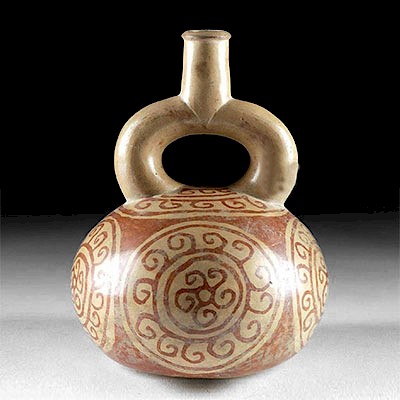Framed Chancay Polychrome Painted Textile
Lot 73b
About Seller
Artemis Gallery
686 S Taylor Ave, Ste 106
Louisville, CO 80027
United States
Selling antiquities, ancient and ethnographic art online since 1993, Artemis Gallery specializes in Classical Antiquities (Egyptian, Greek, Roman, Near Eastern), Asian, Pre-Columbian, African / Tribal / Oceanographic art. Our extensive inventory includes pottery, stone, metal, wood, glass and textil...Read more
Estimate:
$1,800 - $3,500
Absentee vs Live bid
Two ways to bid:
- Leave a max absentee bid and the platform will bid on your behalf up to your maximum bid during the live auction.
- Bid live during the auction and your bids will be submitted real-time to the auctioneer.
Bid Increments
| Price | Bid Increment |
|---|---|
| $0 | $25 |
| $300 | $50 |
| $1,000 | $100 |
| $2,000 | $250 |
| $5,000 | $500 |
| $10,000 | $1,000 |
| $20,000 | $2,500 |
| $50,000 | $5,000 |
| $100,000 | $10,000 |
| $200,000 | $20,000 |
About Auction
By Artemis Gallery
Jan 24, 2019
Set Reminder
2019-01-24 10:00:00
2019-01-24 10:00:00
America/New_York
Bidsquare
Bidsquare : Pre-Columbian / Ethnographic Art
https://www.bidsquare.com/auctions/artemis-gallery/pre-columbian-ethnographic-art-3814
Featuring ancient and ethnographic art from around the world, including Pre-Columbian, Native American, African / Tribal, Ethnographic, Spanish Colonial, Fossils, Fine Art, much more. Artemis Gallery info@artemisgallery.com
Featuring ancient and ethnographic art from around the world, including Pre-Columbian, Native American, African / Tribal, Ethnographic, Spanish Colonial, Fossils, Fine Art, much more. Artemis Gallery info@artemisgallery.com
- Lot Description
Pre-Columbian, Peru, Chancay culture, ca. 1300 to 1470 CE. A sizeable textile, finely woven from camelid fibers, and decorated with six hand-painted panels of front-facing lords or shaman holding weapons in each hand. Three of the figures are presented against a green square that is surrounded by a step-motif border. The backgrounds of the other three figures have faded. Each figure has a similar face, with large, almond-shaped eyes that are lined in black and marked by a black dot to delineate the pupil. These panels alternate with four vertical rows of hummingbirds delineated in green and beige with eyes delineated in black against a rose-red ground. This is a spectacular example of textile art from the Pre-Columbian era. Size: 35" W x 19" H (88.9 cm x 48.3 cm); 37" W x 20.75" H (94 cm x 52.7 cm) framed
Andean textiles often have repetitive, almost fractal patterns, oftentimes surrounded by borders as we see in this example, and with color sequences designed to make the viewer look across them in a diagonal fashion. From ca. 1300 CE onward, Chancay textile motifs began to emphasize anthropomorphic figures rather than geometric abstractions. Some scholars have advanced the theory that frontal figures are gods and figures shown in profile are their attendants.
The people of the early cultures in the Andes buried their honorable deceased in bundles with woven textiles like this. The red color used in this textile was created from cochineal, a bright red insect, while the other pigments were derived from various plants. Thankfully the dry, cold climate of the Andes preserved special textiles like this example.
Provenance: private Southern California, USA collection, acquired in the 1970s to mid-1980s
All items legal to buy/sell under U.S. Statute covering cultural patrimony Code 2600, CHAPTER 14, and are guaranteed to be as described or your money back.
A Certificate of Authenticity will accompany all winning bids.
We ship worldwide and handle all shipping in-house for your convenience.
#141704Expected wear commensurate with age showing areas of fading and staining. Losses to peripheries as shown. Still, much of the imagery is still vivid.Condition
- Shipping Info
-
All shipping is handled in-house for your convenience. Your invoice from Artemis Gallery will include shipping calculation instructions. If in doubt, please inquire BEFORE bidding for estimated shipping costs for individual items.
-
- Buyer's Premium



 EUR
EUR CAD
CAD AUD
AUD GBP
GBP MXN
MXN HKD
HKD CNY
CNY MYR
MYR SEK
SEK SGD
SGD CHF
CHF THB
THB














